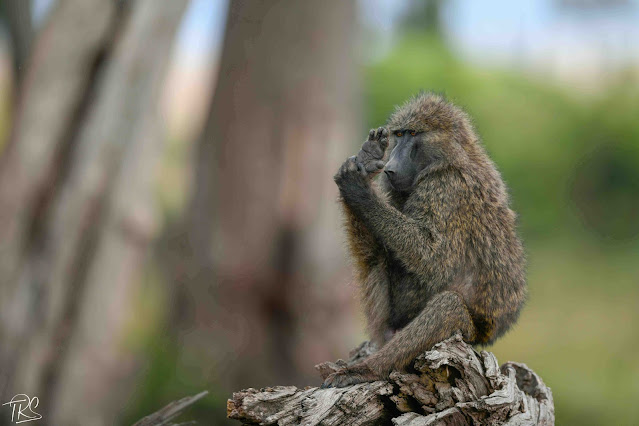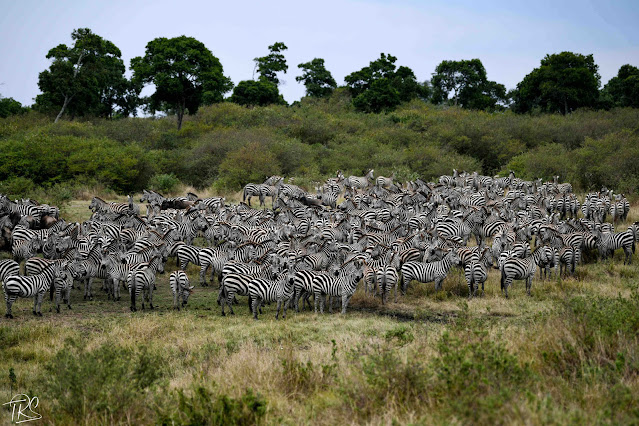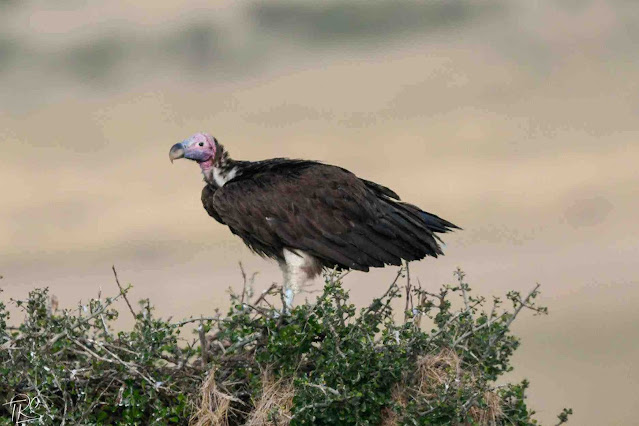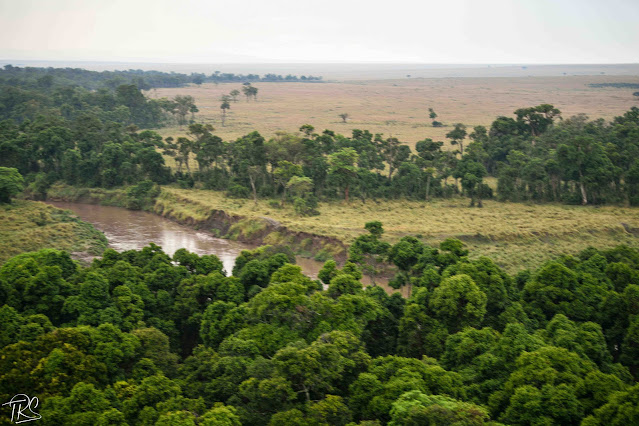Aug 2018
Masai Mara is a very large wildlife park in Kenya that is contiguous with the Serengeti Park in Tanzania. The game reserve has a wide variety of wildlife including all the big five (lions, leopards, elephants, buffaloes, and rhinoceros). It is also the theater for annual river crossing under the spectacular Great Migration.
Masai Mara is 1,500 square km in size. The park is primarily open grassland cut through by three rivers including the Mara river. Masai Mara receives over 300,000 tourists a year. We went on a 8 days photography tour organized by India’s maestro photographer Sudhir Shivaram.
Here is our diary:
The Sun rises over African Savannah and ushers in another day of excitement in finding food; and not being food!
Sunrise at Masai Mara
As the dawn breaks, silhouettes emerge. A giraffe starts grazing. Giraffes are not the first choice of predators since Giraffes can kill with a kick. Giraffes are vulnerable only when they bend down to drink water and expose their neck to attacks. Lions go after giraffes, especially young calves, if and only if other prey are not within reach.
Silhouettes emerge at sunrise. A lone giraffe.
More silhouettes emerge. This time, Topis. Topis are the fastest amongst antelopes; can run at 80 km per hour. Male topis “defend” their territory and have 5 to 6 females in their territory.
Silhouettes emerge at sunrise. Topis.
Elephants emerge to bask in the early morning Sun. Females too have tusks in Africa. Male African elephants are the largest land animals in the world and can be as heavy as 7,500 kg. An elephant’s trunk Is gentle enough to caress a calf and strong enough to kill a lion!
African elephant
African elephant
A buffalo stays with the gang (or obstinacy) in early morning Sun. A friend, the Oxpecker, is riding on its back. The little bird has a symbiotic relationship with the host. An African buffalo is one of the big five (lions, elephants, rhinos, and leopards being the other four); quite dangerous to hunt.
Buffalo
Wildebeest, also known as Gnus, join in. The Wildebeest are antelopes (with horns like a buffalo and legs like a horse). The locals refer to Wildebeest in Swahili as “Sifuri Ubongo” (Zero brains). However, consider: One, they have eight months of sex parties ; proliferate in a three weeks window; and 85% of the young ones survive. Two, no man has ever ridden a wildebeest. Does not seem stupid to me!
Wildebeest
Early morning wakes up beautiful birds too. A Lilac breasted Roller perched on a dead branch brightens up the day! A Lilac breasted Roller is a riot of colours! (Did you know that Zulus would tie together young couples who want to marry using a rope made of the feathers of a Lilac Breasted Roller. If the couple could stay together without breaking the rope, they are a good match. If not, they are not!)
Lilac breasted Roller
A Starling comes quite close to us to check us out and to check out the ground for some food.
Starling
The deadly Shrike bird has found food. The shrike is a surprisingly lethal predator. It is known as “butcher bird” for the ferocity with which it kills a prey as large as its own self using barbed wire fences and sharp branches!
Shrike
A herd of Thomson Gazelles are looking to graze while being watchful for predators. Tommies are relatively at the lower end of food chain. Their specie survives thanks to three advantages: a larger population, an ability to run for a sustained period of time, and an ability to run in a zig zag manner. An early start and a good distance at start are important for Tommies to survive a predator (which can run fast but only for a shorter period of time). Therefore the intense alertness.
When a hungry cat is chasing them, how do babies remember to sense danger, start when the gap is good, start early, and run in a zig zag manner, at a speed that is sustainable? They don’t. They just follow the adults. By staying focused on the distinctly and brightly patterned hind quarter signature of the adults!
These Tommies keep looking at different directions to sense predators and warn the group.
When a hungry cat is chasing them, how do babies remember to sense danger, start when the gap is good, start early, and run in a zig zag manner, at a speed that is sustainable? They don’t. They just follow the adults. By staying focused on the distinctly and brightly patterned hind quarter signature of the adults!
These Tommies keep looking at different directions to sense predators and warn the group.
Thomson gazelles
A lone Grant gazelle and a lone waterbuck look at us with caution. The Grant gazelle is gregarious, territorial, and migratory. Waterbucks are antelopes that stay close to water (they need to drink water every day and prefer the fresh grass near water).
Grant Gazelle
Waterbuck
A dazzle of zebras are enjoying mid morning Sun. Predators find zebras delicious. Zebras, therefore, need to be twice alert and twice cautious. Zebras do not run as fast as horses; however they can run for a longer time and run with a zigzag gait. Zebras have not been domesticated.
Zebras
A Giraffe surveys the land for tall trees with fresh leaves.
Giraffe
Two ostriches out in the wild. The flightless Ostrich is the largest bird in the world with eyes to match. An Ostrich can kill a lion with a forward kick. Ostriches can run fast; at 70 km per hour.
Ostriches
Baboons are the largest monkeys in the world. Baboons stay on the ground much of the time though they do sleep, eat or keep watch in trees. Baboon troops have a social hierarchy. Baboons communicate with each other through vocalisations; and may have thirty different sounds to express different thoughts.
Baboon
A new day does not mean peace. You need to find food. You should not end up being food. The Savannah goes by one principle: survival of the fittest. A Mongoose on full alert.
Mongoose
Savannah at breakfast time. A variety of prey that has to graze at the vast open plains.
The hunter has to stay downwind (so that it is not detected by the prey) and inch its way forward to get as much proximity to the prey as possible. If the distance at start is low, its overwhelming speed (that can be sustained only for a very short while) could get it lunch. If not, starvation.
The prey has to stay alert, start running as early as possible, and while the hunter is far away enough to not make up the gap! Running zig zag would help since hunters cannot run with a zig zag gait. The babies and the sick are the most vulnerable.
The prey has to stay alert, start running as early as possible, and while the hunter is far away enough to not make up the gap! Running zig zag would help since hunters cannot run with a zig zag gait. The babies and the sick are the most vulnerable.
The scavenger has to eat but cannot hunt. It has to follow the hunter and either settle for left overs or steal the hunt using its numbers to its advantage. Forty hyenas versus five lions and one moment of distraction!
Savannah at breakfast time
If you are a buffalo, topi, gazelle, or wildebeest in the Savannah this is the sight you do not want to see at such close quarters!
Not the one you want to see at close quarters
Job done. The predator feasts on the hunt. Growling to keep the hyenas and vultures away. The predators start on the prey from behind and work through to head. They leave the stomach untouched. A puncture of the stomach would spread the smell far and wide attracting scavengers.
Lioness, with her hunt, a Topi
Waiting scavenger: Vulture
Waiting scavenger: Jackal
Savannah is not just about hunting alone. Savannah is all also about romance. A lioness and a lion separate from the pride to have a good time. (Lions mate multiple times a day).
Lion, the groom
Lioness, the bride
Lion cub, at its most vulnerable age
Not every hunt results in a kill. Often times the herd escape. And the hunters regroup to plan the next hunt to find another mark for the day.
Cheetahs waiting after a failed hunt
The leopard is a loner. Owns a wider territory than lions and a smaller territory than Cheetahs. Leopards run fast; up to 58 km per hour and can leap forward 6 m or upward 3 m. It has an "ambush and pounce" style hunt. Leopards are the smallest among the wild cat category; but are quite strong in relation to their weight. They can haul their prey up tree branches beyond the reach of hyenas and lions. Leopards are very elusive and difficult to spot in the wild. The lady is scouting for food.
Leopard
And she got it. A Thomson gazelle, for lunch. Carries it across the narrow opening to its cubs on the other side of the mud track road; giving us an ephemeral, evanescent moment to capture the shy and private hunter.
Leopard with her kill, a Thomson gazelle
The Great migration that happens in Africa is a year long circular movement. More than 2 million animals (Mostly wildebeest, gazelles, and zebras) move in a circular path northwards and southwards in search of fresh pasture and water. It is a 800 km circular route that keeps going on and on. No, it is not as old as Africa. It is just a recent thing that started in 1960s.
In the course of the migration, the animals need to cross rivers. Crossing the Mara river in Masai Mara, as part of this annual cycle, is a big ticket event. In a typical crossing, 10% would lose their lives to predators waiting at the banks and 90% would survive to get good food. Leaders of animal packs have to decide on the odds of loss of life and the odds of fresh food at every crossing.
We saw a large dazzle of zebras head to the bank, see some crocodiles, and decide to not cross the river that day. Sometimes it takes three or four assemblies and evaluation before the leader plunges into the river. Once the leader plunges, everyone else follows.
A dazzle of Zebras at river crossing. Leader is having a Macbeth moment.
And spots a crocodile, waiting patiently by the river
Not now. Better to cross later. And the Topis agree
Reassembly with the entire dazzle intact
Not everyone at the river is tense. Some have fun and frolic since they are not at the lower end of the food chain and prefer vegetarian food (though an occasional go at meat is not unusual).
Hippo having fun in the river
Hippo having fun at the river
Not all predators are four legged. Some re two legged. Perched above a high tree, with wings powerful enough to give it a high speed dive, the Tawny eagle looks around for prey.
And a scavenger keeps an eye on the hunter.
Tawny Eagle
Lappet faced vulture
The Secretary bird is a left over of the "terror birds" of pre historic era that tells us how terrifying birds were int eh past. Secretary birds stamp on, stun, and swallow the prey! Though our guide gave several interesting stories about the reason for their name, research shows that it comes from the Arabic word “Saqr-et-tair” meaning “hunter bird”.
Secretary bird
Topis run quite fast at 80 km per hour (one of the fastest among antelopes). We saw a pair run right next to our jeep at very high speed and overtake our fast jeep with ease. Female Topis are on heat for just one day in a year; and competition to get a male is quite intense; an animal version of “The Bachelor”.
Topis
A good way to size up the Masai Mara is on a hot air balloon ride early morning.
Hot air balloon ride
Masai Mara is a grassland cut through by three rivers, with trees and bushes dotting along the banks of the rivers. The grass feeds the lower end of the food chain. The trees give a place to hide the hunters. The water helps the trees and grass grow.
Masai Mara Landscape
, from hot air balloon
Two eagles are enjoying a vista from above; scouting for food from commanding heights.
Two eagles with a commanding view, from a hot air balloon
In good style we bade good bye to Masai Mara with our last stop to watch a herd of elephants.
A herd of elephants
The place we stayed at was adventurous too. We stayed at Governor’s private camp within the Park right next to the river. A tent with zipper doors. Floors that shake up/down when you walk. We had visitors during night time. One evening there were hippos (of course, we had armed guards in the camp area!). One night, giraffes were seen loitering just outside our tent. One afternoon, the entire camp was occupied by a herd of elephants and our jeeps had to patiently wait outside the gate until they all went away.
Cottage #7 in Governor’s Private Camp within the Park
In Masai Mara, animals have the right of way. All the time.













































Vividly brought back memories of our visit.details very interesting as usual.especially stay at governors private camp.adventuroustoo.very enjoyable narrative .
ReplyDelete